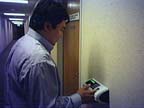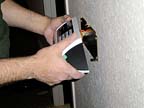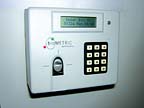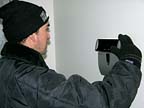With that kind of popularity comes a problem. Owner Jeff Reuter has several silent-partner investors who are welcome inside at any time, but doormen might not recognize them.
“I put in this biometric system on our VIP entrance so partners and people who come in all the time wouldn’t have to wait in line, and so we don’t have to guide them around the line,†Reuter explains. Just inside the special entrance is a large table that seats 16 and always has a “reserved†sign on it, where those using that entrance know they can sit.
“The biometric reader is under the radar,†notes Reuter. “Nobody knows about it except the people who need to get in.†About 20 people can gain access through the system, which is based on fingerprint technology. Installed by UPS Security Systems, Orange, Calif., the system uses equipment from Bioscrypt and AMAG.
The only challenge with the system was that the reader was to be installed outside, notes UPS Security president Randy Jara. “We had to get a custom box made because the biometric reader had components that aren’t in the back of standard proximity readers,†he reports. Reuter and other customers like the reader because of its compact size, adds Jara.

Photos courtesy of the City of Los Angeles
LA Mayoral Access
Controlling access to the office of a high-profile, time-constricted leader such as the mayor of Los Angeles is a delicate balancing act. Although a high level of security is a must, it also is important not to inconvenience the mayor and other high-ranking officials.For the City of Los Angeles, the solution was to install a fingerprint reader system that was configured with two different levels of security. For the vast majority of users to gain access, both a fingerprint and a key card are required. But for the mayor and a handful of other high-ranking officials, an authorized fingerprint scan is sufficient.
“We wanted higher security to be as transparent as possible and we wanted people to feel as safe as possible,†explains Dwayne Healy, security technical administrator for the City of Los Angeles. The dual verification system is made possible by a custom interface that the installing company, RD Systems of Tustin, Calif., had written for it. The system, which protects about a dozen doors in several city facilities, uses equipment from HID Corp. and Bioscrypt.
For the mayor’s office and the council chambers, fingerprints are stored on the reader, explains Chris Gustafson, RD Systems director of operations. For other locations, the system checks that fingerprint information on the user’s key card matches the reading that it gets from each user.
“When users present their cards, the system is only checking their fingerprint against their card, rather than a server somewhere,†explains Healy, adding that users are happy with the system response time.
Because of the added security that the system provides, the city eliminated the need for guards who were previously stationed in shifts at the mayor’s back door. Those guards had skills and credentials that were similar to those of police officers, costing the city about $140,000 a year for the equivalent of two full-time guard positions. The city was able to re-deploy them.

Photo courtesy of iAccess Systems Inc.
Stun Gun Facility
When a client’s business is making a high-tech product, it only makes sense for the access control system protecting the client’s premises also to be high-tech. “We wanted something that would showcase our state of the art in the technology field,†notes Raymond Rivera, chief information officer for Taser International, manufacturer of “less than lethal†weapons, commonly referred to as stun guns.At press time, Taser was about to open a new facility in Scottsdale, Ariz., which has iris readers from LG Electronics connected to an access control system from PCSC. The system had been in use for several weeks to control access while the facilities were made ready for employees and it had been functioning “flawlessly,†according to Rivera.
One of the things Rivera likes about the technology is that it has a strong track record, having been used at several airports in Europe. “Airports have tons of people flowing through and that proves the durability,†Rivera notes.
Rivera also likes the fact that the iris scan system does not require employees to remember pass codes and that it does not use any pass cards that would have to be replaced if they were lost or stolen. He also believes employees will perceive that the system is more hygienic than systems requiring them to touch their hands to a reader.
As Rivera describes it, each iris scan reader resembles an “oversized eyeball,†which users can adjust by sliding up or down. Users must get within 8 inches to 10 inches of the reader for it to scan properly. “If you’re too close, it tells you,†Rivera explains.
Although some of Taser’s 280 employees initially were concerned that the reader might hurt their eyes, Rivera was able to address those concerns by having a representative from LG come to the premises to review the system with employees. Enrolling employees in the system was a quick process, Rivera maintains.
Taser’s biometric system, Rivera declares, “offers great versatility, less overhead management and provides consistent and strong access control.†Ryan Companies US Inc., Phoenix, was the general contractor for Taser’s new location.
Ryan Companies enlisted Walters and Wolf Construction Specialties, Chandler, Ariz., which also handled the video surveillance system, to install the 52-reader biometric access system. The project was “constantly evolving,†notes Robbie Knight, senior project manager for Ryan Companies.
“Taser got more and more ideas about what they wanted as we went along,†Knight related. “Walters and Wolf stepped up to the plate in collaborating with Taser in terms of what they were looking for and coming up with a solution for it.â€

Cold Storage for Food
“Over the last few years, the USDA has been really tightening up on who is getting access to the nation’s food supply,†notes Dean Andrews, president and owner of Integrated Access Solutions, Inc., Chicago. This new reality prompted Frozen Assets Cold Storage, an operator of cold storage facilities, to enlist Integrated Access to install an iris reader at one of its new locations.“Everybody who goes in or out must give a reading of their iris,†Andrews explains. “We know who’s there at any time so if there is any kind of incident, we know who is in the facility.â€
Frozen Assets, which has between 30 and 40 employees, also uses the system as a more sophisticated alternative to punch cards and a time clock for tracking attendance. “The problem with punch cards is you don’t know who’s punching the card,†Andrews points out, which the iris reader overcomes.
The biometric system was installed to help satisfy the requirements of security-conscious food industry clients such as McDonald’s and Sysco, notes Dave Smith, Frozen Assets’ sales and operations manager. Companies such as those insist that no unauthorized users should have access to products in warehouses where their food is being stored. “They follow the food chain all the way back to the manufacturer of the raw material,†Smith says.
Iris readers were chosen rather than fingerprint or hand geometry readers because the cold temperatures inside the facility require employees to wear heavy gloves. “They would have had to keep taking them off and putting them on again,†he notes.
The three-reader system uses equipment from Panasonic that Andrews declares “has been one of the easiest and most reliable pieces of biometric equipment we’ve ever used.â€

Photos courtesy of Genzyme
Pharmaceutical Security
A pharmaceutical laboratory, such as that of Genzyme, Cambridge, Mass., requires a higher level of access control than most businesses. To address that need, Genzyme uses a Honeywell access control system with fingerprint readers from Bioscrypt, which are installed throughout a section of the company’s facilities. Twelve readers control access for approximately 300 employees.The system works in combination with employee pass codes, explains Bhavesh Patel, Genzyme’s director of global information security. When an employee enters his or her pass code, the system brings up that person’s fingerprint record or template, then asks the person to hold out his or her finger for scanning and verifies a match. The system replaced a hand geometry unit that the company used previously to control a single entry point but could not be networked.
The fingerprint-based system suits the company’s needs, Patel emphasizes. He notes that the system does not have turnstiles which could help prevent “tailgating,†where someone without credentials slips through behind an accomplice who does. However, Patel is not particularly concerned about that vulnerability. He advises that anyone planning such a system ask, “Are you building an office or a fortress?â€
Patel would like to add fingerprint-based security to control access to the company’s computer network, but he believes manufacturers still have development work to do there. “The issue is central management of templates for the convergence of physical and logical security,†he declares. “We’re seeing a lack of template management from a central system.â€
Genzyme’s biometric access control system was installed by TeamAVS, Billerica, Mass.

Photo courtesy of Frozen Assets Cold Storage
Biometric Convenience
Some businesses make the choice to install biometric access control systems simply because they are more convenient than conventional alternatives. One such company is Capital Direct Lending, a mortgage company in Costa Mesa, Calif.“We have high turnover and getting keys back from employees who left was a constant problem,†explains Mario De Vera, vice president of Capital Direct Lending. “With this device, we simply delete their code from the system.â€
The device to which De Vera refers is a stand-alone reader from iAccess Systems Inc. that uses a combination of a pass code and blood vessel authentication to control entry. The system works in a manner similar to that of fingerprint readers, but rather than matching fingerprints, it matches the unique blood vessel pattern in a finger.
IAccess claims a false acceptance rate of 0.0001 percent and a false rejection rate of 0.01 percent, which it maintains far surpasses the performance of most fingerprint-based systems at a cost that is about 25 percent higher.
That level of performance is comparable with iris scan technology at a cost 25 percent to 50 percent less than iris scan, the company calculates. Capital Direct chose the system because it was less expensive than iris scan systems but seemed more reliable than fingerprint-based systems.
The company uses the reader, which was installed by iAccess technicians, to control access for 12 employees to the office’s front door. Cleaning personnel can gain entry through a back door using a conventional key.
“It’s working out great,†De Vera reports. “It’s been easy to use and administer and we’ve been really pleased with it.